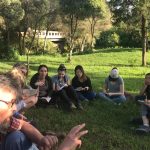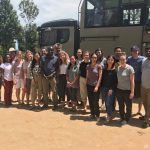Blog post by Evelyn and Davin
It’s hard to believe that a week has passed since we departed on our journey to Kenya. We have enjoyed so many unique adventures thus far, already leaving us with a plethora of lasting memories. Today we awoke at the crack of dawn to try our luck at some morning bird watching, with hopes of getting that perfect shot. Steve, Evelyn and Davin dawned cameras and headed out. At this time of day the main gates of Angiri Camp aren’t yet open; nevertheless, there are many birding opportunities within the camp. As we strolled along we watched a variety of local species including the Common Fiscal, Speckled Mousebird, Baglafecht Weaver, Ring-Necked Dove, Bronze Sunbird and Cape Robin-chat. Following our stroll, we were joined by the rest of our group for breakfast.
On a personal note, birding has never been a passion of mine (Davin), although I’ve had an appreciation for animals since I was young. Something about the beauty of Kenya, or the magnificence of its creatures affected me from our first game drive in Nairobi. Equipped with a camera, I was fixated on each creature we encountered, but there was something more powerful about our winged friends. Their quick movement and unpredictable behaviour was an instant attractant, and a new love and appreciation for birds formed. I’m not sure whether this novel passion will subside, but at the moment the vastness of this new avenue fills me with hope and joy.
Over the course of the day, our five graduate students each presented a peer-reviewed paper from the primary literature on patterns of biodiversity on topics that included environmental correlates of phylogenetic endemism, and the latitudinal gradient in biodiversity. It was good to spend time thinking about these broader patterns and making connections to what we see around us. Where we are in Laikipia is a plant biodiversity hotspot!
Just before lunch, we also had a fascinating and challenging talk from Dr Mordecai Ogada, coauthor of the book “The Big Conservation Lie”. He shared with us his frank opinions on what he sees as the crisis in African conservation, where human circumstances come second to the big business of conservation. He cautioned us to be sceptical of the saviour narrative built around individual conservationists and to recognize the role of imagery and media in spinning stories about situations in Africa. He was a very compelling speaker, and gave us a lot to contemplate. The discussion built really well on the debates we had over the last few days. We are all excited to read The Big Conservation Lie, and Dr Ogada is going to drop off signed copies for us later this week.
It turns out that I (Davin) am not the only one with an emerging passion for birds, as other participants seem to be catching the bird ‘bug.’ While we eschewed the possibility of working outdoors during the heat of the day, we were able to go on another bird walk later in the afternoon with the entire class to learn more about the local avifauna. This time we broke into groups and ventured out with cameras, binoculars and a bird identification guides for each group in pursuit of new species – seeking to key them out on our own. As we sauntered down the tree-lined country road, we saw small local farms, a variety of farm animals and yes, birds. It was interesting to see a local herder push cattle up the road for their evening return to the paddocks, and to see the local school bus dropping off students after their school day. There are always reminders of some of the trials endured by local rural Kenyans, disparity of wealth and power, all of this portrayed poignantly by the image of an elderly woman walking up the road with an orphaned boy. Resilience. We stopped for a brief yet thorough tutorial of strategies for identifying the myriad bird species here and elsewhere by our resident expert Steve. Following this learning moment we headed back to camp for dinner and our evening debriefing. Week one complete!
Click on the thumbnails to see larger images
- Red-cheeked cordon-bleu
- White-eyed slaty-flycatcher
- Steve holding forth on bird ecology and identification
- A local woman with child
- A parade of local cows.
- Class with Dr. Mordecai Ogada.
- Evelyn and Steve
- Hannah giving her seminar on hypotheses on the latitudinal gradient in diversity








Leave a Reply